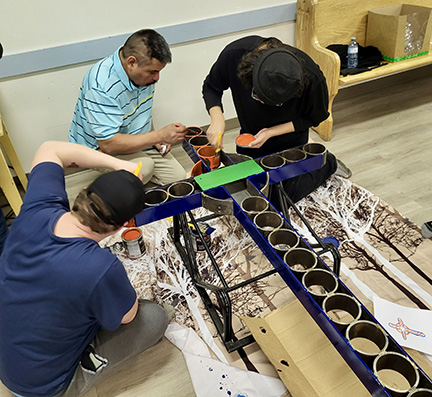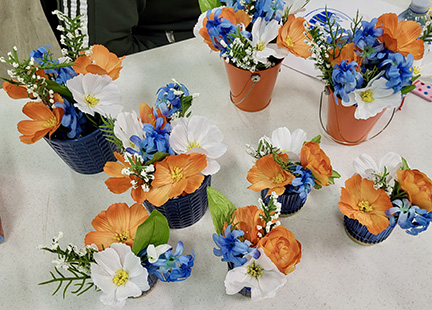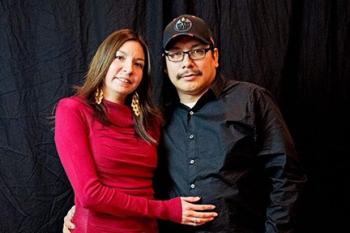Image Caption
Summary
Local Journalism Initiative Reporter
Windspeaker.com
Wesley Wanuch grew up in Paddle Prairie, a member of Beaver First Nation in Treaty 8 territory. He had lived at Cold Lake First Nations ever since marrying his wife, Gwen Wanuch, 15 years ago.
Wes died on the morning of Feb. 4. RCMP had attended his residence that day where, they contend, a confrontation took place resulting in “at least one” officer discharging a firearm.
When RCMP entered the home, “the suspect, a 45-year-old male resident of Cold Lake First Nation, was found deceased... Firearms were found in the residence,” reads an RCMP press release.
For family and friends who loved Wesley, Valentine's Day was spent pitching in and helping in different ways. One woman put the final touches on a star blanket, while others worked on Oilers-themed beadwork. In the kitchen, a group cut up vegetables to help a Cold Lake First Nations caterer who had volunteered to cook a dinner for everyone on Feb.15. A group of teens arranged and organized pictures, putting them in frames to place on the tables. Another group sat together to make flower arrangements.
The blanket was for Wes’ casket, the flowers for his gravesite. Pall bearers wore the Oilers-themed armbands, as Wes was an avid fan of the Edmonton NHL team.

Pam Janvier’s son Cody Charland had a cross designed and welded at the Seven Lakes Welding division, the cost of which will be deducted from his pay. Wes was a welder by trade. A group of men painted the cross.
Although it is tragedy and grief that brought the group together, Janvier says “we have made new friends and they are considered our family.”
Janvier is the Wanuch family spokesperson as they navigate shock, grief, medical examiner, coroner, and the Alberta Serious Incident Response Team (ASIRT), which has taken over the investigation into circumstances surrounding the officer-involved shooting.
What’s clear to the family, said Janvier, is that “this was a mental health issue.” She explained the situation that led to the police interaction with Wes as she understands it.
While the RCMP news release states that “Cold Lake RCMP received a firearms complaint from a residence in Cold Lake First Nations,” Janvier says that’s not what the family has said.
“From what I have been told, the initial 911 call did not say there was a gun involved, but a gunshot was heard while the young man was on the phone” to RCMP.
Wes’ youngest son had called 911, “but couldn’t talk because he didn’t know what to say, so he handed the phone off to (another) young man.” According to Janvier, that young man told the dispatcher that “his aunty and uncle were arguing.” He remembers the call cutting off. And then he exited the trailer, Wes’ home.
Janvier has arranged to meet with the RCMP staff sergeant, as well as his second in command, “because I just have some questions about their procedure and how they went about this,” she said.
“I would like answered, as a nation member, you came onto my nation and this is what you did. Why did it go like that? What in your policy or procedure makes you go to that extreme when there were other alternatives?”
Janvier suggested they could have “brought in a negotiator or brought in an Elder” to help with the situation.
“They stood outside with their guns drawn, pointed at that trailer until one o'clock” until a drone and the SWAT team got there, she told Windspeaker.com. “What is the use of standing there pointing your guns at a dead man?”
RCMP, and other police services, involvement in dealing with mental health situations has been under scrutiny across Canada, including in the shooting death of Chantel Moore by the police in New Brunswick on June 4, 2020 and in the RCMP shooting of Rodney Levi of the Metepenagiag Mi’Kmaq Nation on June 12 of that same year.
Wes’ family and friends can’t help but question how police responded to a call on their lands with “the force they used to end the situation,” says Janvier.
She feels a marked lack of respect from the RCMP during the situation.
“I know they're doing their job, but no. Somebody was just shot here. A loved one was shot. You can't be gruff and demanding and barking orders when emotions are running so high. There was no cultural awareness at all.”
Gwen Wanuch, Wes’ wife and now widow, returned to the scene on the Sunday morning after the shooting death of her husband.
Janvier says that Gwen was getting out of the vehicle when an officer approached her. “The first words that came out of his mouth was, ‘Gwen, are you drinking this morning? Are you drunk?’”
Janvier said Gwen was told by ASIRT she could see Wes’ body before the coroner took him to Edmonton.
“So she waited, because [ASIRT] told her, ‘we will text you, we will call you’. So she waited and waited, anticipating on the phone for this text message.” Janvier said RCMP stood guarding the trailer where Wes lay until Sunday evening.
Janvier said she had a bad feeling, so her husband asked a neighbour of the Wanuchs to “keep an eye out for the coroner’s van. Call us when it gets there.”
“We got the call from our neighbor that they're here, and they're taking him out. And so ASIRT did not even contact (Gwen) to let her know that they were there removing him.”
Janvier said there were also “threats of being charged for obstruction for being there when the coroner was there trying to take him.”

Janvier also described some confusing communication around when the body would be returned for burial. The family said they were told the funeral home could pick Wes’ body up in Edmonton on Friday, Feb 10, so they began planning a wake for that day and a funeral for Saturday, Feb 11. Janvier says the funeral home sent their driver to Edmonton to get the body Thursday.
“The funeral home was there, spending the night of Thursday night in Edmonton, waiting for early morning so that they could bring the body back, and nothing. They weren't allowed. They were told they had to wait till Monday.”
When Wes’ brother called the medical examiner, he was told they were waiting to identify the remains.
When Windspeaker.com spoke to a representative of the funeral home, we were told “Wesley's wake and funeral were tentatively booked for Friday and Saturday, pending the medical examiner's investigation. I did have an attendant in Edmonton doing errands and if the medical examiner called and had their investigation complete, we would have been able to bring Wesley home.”
The family are also upset about the comment in the RCMP news release that states, “firearms were found in the residence”, as though that provided cover for RCMP actions.
“Of course, there's firearms in there. He's a hunter. He has his PAL (Possession and Acquisition Licence). They're legal to be there,” said Janvier. She said Wes was a strong provider for his close-knit family.
Comments made about the incident on social media posts also hurt the family. Those comments suggested that Wes was gang-affiliated or a criminal.
“And that’s what it seems to be being portrayed as ‘Oh, just another Native’.”
Janvier describes Wes as “the type of person where it could be 40-below outside and ‘Wes, can you come and help me? I'm stuck.’ It could be any time during the day, night, whatever. Wes would be there. He wouldn't ask for anything in return and, you know, how when if somebody asks you for help in the middle of the night, you're kind of growly? Wes didn’t. He wasn't like that. He willingly helped. He would've given you the shirt off of his back if he had to.”
Because the incident is under investigation, RCMP will not comment until ASIRT’s investigation is completed.
The whole situation has Janvier thinking back to another police shooting on Cold Lake First Nation on Aug. 15, 2013, the killing of Daniel Charland. RCMP fatally shot Daniel Charland in the home of his mother, Elder Elise Charland.
A press release issued in 2018 by the First Nation discusses details of the shooting as the notice of a Public Fatality Inquiry was shared.
Officers had entered the Elder’s home unannounced under authority of a Feeney Warrant to arrest Daniel for alleged criminal offences. A Feeney Warrant is a warrant to enter a dwelling to make an arrest, but it’s intended for instances of fresh pursuit or potential for destruction of evidence or imminent danger to life or grievous bodily harm. Daniel, his mother Elsie, his brother Ira and Ira’s partner were home at the time watching a movie. Daniel was shot in front of them.
Daniel’s death and the circumstances surrounding the warrant “negatively impacted CLFN’s relationship with the RCMP”, reads the First Nations’ statement.
“Unfortunately, it is this type of tragedy that perpetuates a relationship of distrust between the authorities and our communities,” said CLFN Councillor Dean Janvier. Councillor Janvier saw the incident as an indicator that RCMP needed to review their processes immediately, especially as they pertained to Indigenous peoples and matters occurring on-reserve.
“Daniel Charland’s death was avoidable. There are many cases like this across the country where our Indigenous people are suffering the same, unnecessary fate. Something needs to change,” the councillor said.
The press release went on to say: “Too many Indigenous persons, particularly men, are dying at the hands of police officers. Between 2010 and 2017, of the individuals in Alberta who died at the hands of a police officer, more than 25% were Indigenous, despite only making up 7% of Alberta’s population.”
Local Journalism Initiative Reporters are supported by a financial contribution made by the Government of Canada.

